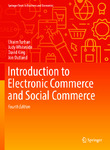| dc.description.abstract | The global economic crisis of 2009–2014 forced organizations to reduce expenses in an environment
of reduced economic activities. One of the most popular cost-reduction activities is
conducting more business online. Actually, we are experiencing one of the most important
changes to our daily lives—the move to an Internet-based society. Internet World Stats (internetworldstats.
com) reported in 2014 that more than 83% of the North American population
surf the Internet (Fall 2015). The large number of people on the Internet is one of the major
drivers of conducting business online, which is known as electronic commerce, or in its broader
scope as e-business.
Electronic commerce (EC) describes the manner in which transactions take place over
networks, mostly the Internet. It is the process of electronically buying and selling goods,
services, and information. Certain EC applications—such as buying and selling stocks and
airline tickets on the Internet—are growing very rapidly, exceeding non-Internet trades. But
EC is not just about buying and selling; it is also about electronically communicating, collaborating,
and discovering information. It is about e-learning, e-government, e-health, social
networks, and much more. Electronic commerce has an impact on a significant portion of the
world, including developing countries, affecting businesses, professions, and most importantly
people. | en_US |

